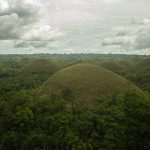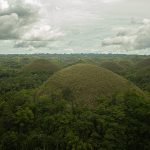Download links
How to install Discover the Mysterious Chocolate Hills APK?
1. Tap the downloaded Discover the Mysterious Chocolate Hills APK file.
2. Touch install.
3. Follow the steps on the screen.
Description
The Chocolate Hills, a geological wonder located in the Bohol province of the Philippines, have captivated the imagination of both locals and tourists alike. Their formation is attributed to a combination of geological processes that took place over millions of years. The hills are primarily composed of limestone, which was formed from the accumulation of marine organisms in a shallow sea that once covered the area.
Over time, tectonic activity caused the land to rise, exposing the limestone to erosion from rainwater and other natural elements. This erosion sculpted the landscape into the distinctive conical shapes that we see today.
During the dry season, the grass that covers the hills turns a rich brown color, resembling chocolate, which is how they got their name. Conversely, during the rainy season, the hills are lush and green, creating a striking contrast to their dry-season appearance. This cyclical transformation not only adds to their allure but also highlights the dynamic nature of the landscape shaped by both geological and climatic factors.
Key Takeaways
- The Chocolate Hills are a geological formation in the Bohol province of the Philippines, with a unique origin story involving giants and a tragic love story.
- The hills are made of limestone and were formed from the uplift of coral deposits and the action of water and erosion over millions of years, creating their iconic conical shape.
- Local folklore attributes the formation of the hills to the tears of a giant who wept over unrequited love, adding a touch of mystique to the natural wonder.
- The Chocolate Hills are home to a diverse range of flora and fauna, including rare species of plants and animals that have adapted to the unique environment.
- Tourists can explore the Chocolate Hills through activities such as hiking, ziplining, and ATV rides, and can also visit nearby attractions like the Tarsier Sanctuary and the Butterfly Conservation Center.
- Conservation efforts are in place to protect the Chocolate Hills, including reforestation projects and sustainable tourism practices to ensure the preservation of this natural treasure for future generations.
The Unique Geology of the Chocolate Hills
The geological composition of the Chocolate Hills is a fascinating subject for geologists and nature enthusiasts alike. The hills are primarily made up of limestone, which is a sedimentary rock formed from calcium carbonate. This rock type is particularly susceptible to weathering and erosion, which has played a crucial role in shaping the hills’ unique forms.
The process of karstification, where soluble rocks like limestone dissolve in water, has led to the development of these conical hills. As rainwater seeps into the ground, it gradually erodes the limestone, creating depressions and valleys that contribute to the overall landscape. In addition to their limestone composition, the Chocolate Hills are also characterized by their uniformity in shape and size.
Most of the hills range from 30 to 50 meters in height and exhibit a similar conical form, which is a testament to the consistent geological processes that have shaped them over time. The sheer number of these hills—estimated to be around 1,268 to 1,776—adds to their uniqueness and makes them one of the most recognizable natural landmarks in the Philippines. The interplay between geological forces and environmental conditions has resulted in a landscape that is not only visually stunning but also rich in scientific significance.
The Legend and Folklore Surrounding the Chocolate Hills

The Chocolate Hills are steeped in local legend and folklore, which adds an enchanting layer to their already captivating presence. One popular tale tells of two giants who engaged in a fierce battle over a beautiful maiden. As they fought, they hurled boulders at each other, causing chaos across the land.
Eventually, they grew tired of their conflict and decided to bury their differences. In their wake, they left behind the mounds of earth that would become known as the Chocolate Hills. This story not only explains the hills’ origin but also reflects the rich cultural heritage of the Boholano people.
Another legend speaks of a giant named Arogo who fell in love with a mortal woman named Aloya. When Aloya passed away, Arogo was heartbroken and wept for her loss. His tears formed the hills as they fell to the ground, creating a landscape that mirrored his sorrow.
This poignant tale illustrates themes of love and loss while also providing a mythical explanation for the hills’ existence. Such stories are integral to local culture, as they connect the community to their natural surroundings and offer insights into their values and beliefs.
The Flora and Fauna of the Chocolate Hills
| Flora and Fauna | Metrics |
|---|---|
| Plant Species | 1,268 species of plants |
| Butterfly Species | 147 species of butterflies |
| Bird Species | 98 species of birds |
| Mammal Species | 27 species of mammals |
| Reptile Species | 25 species of reptiles |
The biodiversity found within and around the Chocolate Hills is as remarkable as their geological features. The region is home to a variety of plant species that thrive in its unique environment. Grasses dominate the landscape during the dry season, giving way to lush vegetation during periods of rainfall.
Some endemic species can be found here, including various types of ferns and flowering plants that have adapted to the limestone-rich soil. These plants not only contribute to the visual appeal of the hills but also play a crucial role in maintaining soil stability and preventing erosion. In addition to its diverse plant life, the Chocolate Hills are also inhabited by various animal species.
Birds such as the Philippine tarsier—a small primate known for its large eyes—can be spotted in this region. The tarsier is an endangered species and is often associated with Bohol’s natural heritage. Other wildlife includes various reptiles, insects, and small mammals that contribute to the ecological balance of this unique environment.
The presence of these species highlights the importance of preserving this area not only for its geological significance but also for its rich biodiversity.
Exploring the Chocolate Hills: Tourist Activities and Attractions
Tourism plays a vital role in promoting awareness and appreciation for the Chocolate Hills. Visitors flock to this iconic destination to experience its breathtaking views and engage in various activities that showcase its natural beauty. One of the most popular ways to explore the area is by hiking up to viewing platforms that offer panoramic vistas of the hills stretching as far as the eye can see.
The most famous viewpoint is located at Chocolate Hills Complex in Carmen, where tourists can capture stunning photographs against this surreal backdrop. In addition to hiking, adventure seekers can partake in activities such as ATV rides through designated trails that wind around and between the hills. This exhilarating experience allows visitors to get up close and personal with the landscape while enjoying an adrenaline rush.
For those interested in cultural experiences, local guides often offer tours that include visits to nearby villages where traditional crafts and practices can be observed. These interactions provide insight into Boholano culture and foster a deeper connection between visitors and their surroundings.
The Conservation Efforts to Preserve the Chocolate Hills

Government Initiatives
Local government units have implemented measures aimed at safeguarding this natural wonder from potential threats such as deforestation, mining activities, and unregulated tourism. These initiatives include establishing protected areas around the hills and promoting sustainable tourism practices that minimize environmental impact.
Local residents are encouraged to participate in programs aimed at preserving their natural heritage while benefiting economically from tourism. Educational campaigns raise awareness about the importance of protecting this unique landscape and its biodiversity.
A Cherished Heritage
By fostering a sense of stewardship among locals and visitors alike, these efforts aim to ensure that the Chocolate Hills remain a cherished part of Bohol’s cultural and natural heritage for years to come. The Chocolate Hills stand as a testament to nature’s artistry and resilience, shaped by geological forces over millennia while intertwined with local legends that enrich their narrative. Their unique geology, diverse flora and fauna, and cultural significance make them an essential part of Bohol’s identity. As tourism continues to grow in this region, it becomes increasingly important to balance exploration with conservation efforts, ensuring that this natural wonder remains intact for future generations to admire and appreciate.
FAQs
What are the Chocolate Hills?
The Chocolate Hills are a geological formation located in the Bohol province of the Philippines. They are made up of around 1,200 to 1,776 conical limestone hills, which are covered in green grass that turns brown during the dry season, giving them a chocolate-like appearance.
How were the Chocolate Hills formed?
The exact formation process of the Chocolate Hills is still a subject of debate among geologists. However, it is widely believed that they are the result of the uplift of coral deposits and the action of rainwater and erosion over millions of years.
What is the significance of the Chocolate Hills?
The Chocolate Hills are a major tourist attraction in the Philippines and are considered a natural wonder. They have been declared the country’s third National Geological Monument and are included in the Tentative List for UNESCO World Heritage Sites.
Can visitors explore the Chocolate Hills?
Yes, visitors can explore the Chocolate Hills by climbing the viewing deck in the town of Carmen, which offers panoramic views of the hills. There are also hiking trails and ATV tours available for those who want to explore the area more closely.
Are there any legends or myths associated with the Chocolate Hills?
One popular legend about the formation of the Chocolate Hills involves two giants who were throwing rocks and sand at each other in a fit of rage, and when they reconciled, they left behind the hills. This legend is a part of the local folklore and adds to the mystique of the Chocolate Hills.





